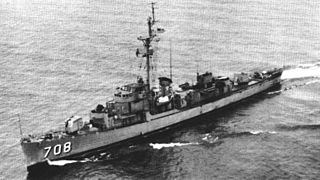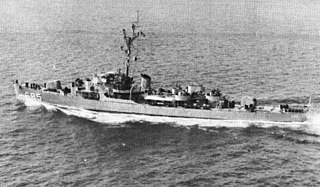
Green Cove Springs is a city in and the county seat of Clay County, Florida, United States. Green Cove Springs is a part of the Jacksonville metropolitan area. The population was 9,786 at the 2020 census.
The third USS Raritan (LSM-540) was a LSM-1-class landing ship medium in the United States Navy following World War II. She was named for a river in New Jersey.

The United States Navy maintains a number of its ships as part of a reserve fleet, often called the "Mothball Fleet". While the details of the maintenance activity have changed several times, the basics are constant: keep the ships afloat and sufficiently working as to be reactivated quickly in an emergency.

USS Sutton (DE-771) was a Cannon-class destroyer escort in service with the United States Navy from 1943 to 1948. In 1956, she was transferred to South Korea, where she served as Kang Won (F-72) until 1977. The ship was then cannibalized for spare parts in the Philippines.

USS Parle (DE-708), a Rudderow-class destroyer escort of the United States Navy, was laid down on 8 January 1944 at the Defoe Shipbuilding Company, in Bay City, Michigan. She was launched on 25 March 1944, sponsored by Mrs. Harry V. Parle, mother of Medal of Honor recipient Ensign John Joseph Parle, and commissioned in New Orleans on 29 July 1944.

Naval Air Station Cecil Field or NAS Cecil Field was a United States Navy air base, located in Duval County, Florida. Prior to October 1999, NAS Cecil Field was the largest military base in terms of acreage in the Jacksonville, Florida area.

USS Menelaus (ARL-13) was laid down as a United States Navy LST-542-class tank landing ship but converted to one of 39 Achelous-class repair ships that were used for repairing landing craft during World War II. Named for Menelaus, she was the only US Naval vessel to bear the name.

USS Clarence L. Evans (DE-113) was a Cannon-class destroyer escort built for the United States Navy during World War II. She served in the Atlantic Ocean and provided escort service against submarine and air attack for Navy vessels and convoys. She was launched on 22 March 1944 by Dravo Corporation, Wilmington, Delaware, sponsored by Mrs. E. E. Evans; commissioned on 25 June 1944 and reported to the Atlantic Fleet.

USS Cates (DE-763) was a Cannon-class destroyer escort built for the United States Navy during World War II. She served in the Atlantic Ocean and the Pacific Ocean and provided escort service against submarine and air attack for Navy vessels and convoys.

USS Otterstetter (DE-244) was an Edsall-class destroyer escort built for the U.S. Navy during World War II. She served in the Atlantic Ocean the Pacific Ocean and provided destroyer escort protection against submarine and air attack for Navy vessels and convoys.

USS Ramsden (DE-382) was an Edsall-class destroyer escort built for the U.S. Navy during World War II. She served in the Atlantic Ocean and the Pacific Ocean and provided destroyer escort protection against submarine and air attack for Navy vessels and convoys. Post-war, she performed other tasks with the U.S. Coast Guard and with the U.S. Navy as a radar picket ship.

USS Tweedy (DE-532) was a John C. Butler-class destroyer escort in service with the United States Navy from 1944 to 1946 and from 1952 to 1969. She was sunk as a target in 1970.

USS Bobolink (AMS-2/YMS-164) was a YMS-1-class minesweeper of the YMS-135 subclass acquired by the U.S. Navy for the task of removing mines that had been placed in the water to prevent ships from passing.

USS Benewah (APB-35) was a barracks ship of the United States Navy, and lead ship of her class. She was notable for her service in World War II, Korean War, and Vietnam War.

USS Ringness (APD-100) was a Crosley-class high speed transport that served in the United States Navy from 1944 to 1946. After spending 29 years in reserve, she was sold for scrapping in 1975.

USS Coates (DE-685) was a Rudderow-class destroyer escort in the United States Navy during World War II and later in the 1950s and 1960s.

USAMP Major General Wallace F. Randolph, sometimes also known as MG Wallace F. Randolph, was a 188.2-foot (57.4 m) mine planter built by the Marietta Manufacturing Company, and delivered to the United States Army Mine Planter Service in 1942. The ship was transferred to the U.S. Navy in 1951, placed directly into the Atlantic Reserve Fleet without being commissioned classed as the auxiliary minelayer ACM-15, then reclassified minelayer, auxiliary (MMA) and named MMA-15, and finally given the name Nausett without any active naval service. After being stricken from the Naval Vessel Register, the ship was transferred to different owners, and eventually was scuttled off the coast of Florida as an artificial reef and fish aggregating device. The site is currently known as the Thunderbolt Wreck, and is considered to be an excellent and challenging dive site for advanced divers.

USS Rednour (APD-102) was a Crosley-class high speed transport that served in the United States Navy from 1945 to 1946. In December 1969, she was transferred to Mexico and served under the name Chihuahua until July 2001.
USS Julius A. Raven (APD-110), ex-DE-600, was a United States Navy high-speed transport in commission from 1945 to 1946. She later served in the Republic of Korea Navy as ROKS Ung Po (PG-83).

USS Beverly W. Reid (APD-119/LPR-119), was a United States Navy high-speed transport in commission from 1945 to 1947 and from 1967 to 1969.






















